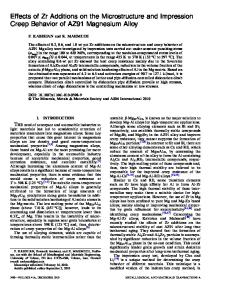Effect of two-step aging on the precipitate structure in magnesium alloy AZ91
- PDF / 1,195,768 Bytes
- 3 Pages / 613 x 788.28 pts Page_size
- 80 Downloads / 277 Views
A. F. CRAWLEYand B. LAGOWSKIare Research Scientists, NonFerrous Metals Section, PhysicalMetallurgy Division, Mines Branch, Department of Energy, Minesand Resources,Ottawa, Canada. Manuscript submitted July 10, 1973. METALLURGICAL TRANSACTIONS
trolyte was - 55~ During polishing, the discs were held in platinum-tipped tweezers. The polished foils were examined in a Philtps EM300 electron microscope equipped with a goniometer stage and double-tilt holder. Selected a r e a diffraction patterns of the matrix and individual precipitates were photographed and measured. A computerized analysis of electron diffraction patterns developed by Milliken 5 was used to determine the precipitate-matrix orientation relationship. The output data from this program whose use is described elsewhere, 8 also includes in-
Fig. 1--Electron m i c r o g r a p h of AZ91 after aging for 96 h at 100~ followed by 192 h at 140~ Photograph shows two r e gions of precipitation--continuous on the left and discontinuous on the right.
Fig. 2 - - E l e c t r o n m i c r o g r a p h of AZ91 after aging for 96 h at 100~ followed by 192 h at 140~ showing continuous p r e cipitation. VOLUME 5, APRIL 1974-949
formation from which the lattice s y m m e t r y and ceil dimensions can be determined to within 0.5 pct. The results of the micrographic examination show that in AZ91, as in A9, 3 two types of precipitates appear. These are: 1) general or continuous precipitates which grow by heterogeneous nucleation; this precipitate is responsible for age hardening; and 2) discontinuous precipitates which nucleate at high angle grain boundaries and grow by a diffusion mechanism; this type of precipitate, massive in form, is detrimental to age hardening of the alloy. The precipitate in both cases is the bcc Mg~TAI~2. No evidence of a precipitate of another composition was found. Fig. 1 shows an electron micrograph of a double-
aged specimen where regions of two types of precipitation are evident--the platelets of continuous precipitate and the lamellar discontinuous precipitate. The matrix of the discontinuous precipitate appears lighter because of preferential thinning during polishing. Figs. 2 and 3(a) present electron mtcrographs of general precipitation in a double-aged alloy (Fig. 2) and the alloy aged at 140~ (Fig. 3(a)). The distinct difference in precipitate size and distribution are immediately obvious. Subsequent examination of the p r e cipitates showed that two step aging did not result in a change in the type of orientation relationship between precipitate and matrix. By selected area diffraction, the precipitate-matrix orientation relationships were established. The general precipitate forms as platelets with a basal growth habit. Using the computer program, the precise orientation relationship between the bcc precipitate and the close-packed hexagonal magnesium matrix was determined as [lll]pp t II [2ii0]matrix (0il)pp t N(0001)matrix Fig. 3(b) shows the diffraction patterns of a [2ii0]matri x and a [lll]ppt zone axes. It should be noted that by t
Data Loading...











